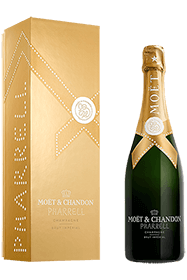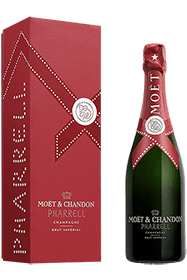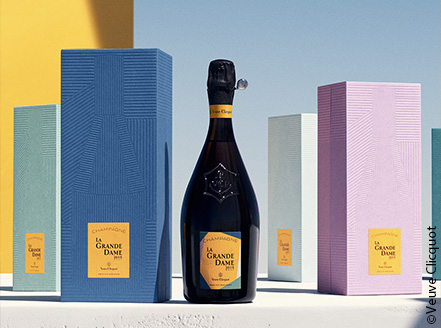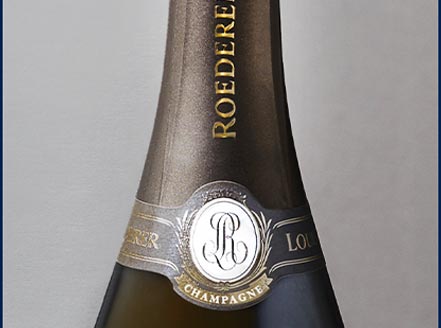Champagne, a word synonymous with celebration
When it comes to celebrating life's most special occasions – be it a birthday, wedding day, anniversary or New Year's Eve – no single wine seems to fit the bill quite like a well-chilled bottle of Champagne. Though the production of this effervescent and gourmet beverage is limited to a small area in northern France, this sparkler exists in a vast variety of hues, flavors and styles, ranging from the elegance and finesse of a Blanc de Blancs to the power and intensity of a vintage Rosé Champagne. Often comprising a blend of several terroirs, grape varieties and vintages, this wine is the epitome of complexity in the glass, whose nuanced aromas and frothy texture on the palate make it the ideal food pairing with your favorite holiday dishes. Whether you’re looking for a magnum champagne bottle for a special gift, an exquisite champagne as the Dom Perignon Champagne or seeking the best champagne for mimosas, our extensive portfolio is guaranteed to have what you are looking for.
Champagne: A Brief Overview
The wines of Champagne are fine, lively wines. They express themselves best when served chilled. The ideal way to chill Champagne wines is gradually, by immersing the bottle in a bucket of ice cubes. These wines get their unique character from their terroir, the harsh northern climate and the implantation of the vines on well-draining slopes. The Champagne region is divided into four main areas: Montagne de Reims, Marne Valley, Cote des Blancs and Cote de Bar. The vineyards of Champagne are planted with three main grape varieties, including the Chardonnay (grown in all of these areas, but also grown the only varietal to be grown in Cote des Blancs), Pinot Meunier (most prominent in Cote de Bar) and Pinot Noir (King of the Montagne de Reims and, to a lesser extent, the Marne Valley). Champagne comes in a wide range of styles, including Blanc de Blanc, Blanc de Noirs and rosé! A bottle of Champagne can also come in a wide range of sizes, called formats.
The history of Champagne & creating the first bubbly
Champagne and French aristocracy
Champagne is home to a rich history of wine production, one which dates back to the Middle Ages, when Pope Urban II first declared these wines to be the best in the world. In 987, Hugh Capet was crowned as the King of France at the cathedral of Reims. This event kick-started a long tradition of coronations and the grandiose and celebratory banquets that came with each event. The alliance between royal celebrations and the town of Reims contributed to the elevation of Champagne's reputation throughout history, and there are still subtle hints to this time in history in the marketing message of these wines today. The region's proximity to the Seine River facilitated the delivery of these fine wines to Paris, further boosting the reputation of the region’s wines in the French capital.
Burgundy vs. Champagne
Before the existence of railways, this region and Burgundy were the two main suppliers of wines to Paris, thus, the two regions were in fierce competition. During this time, both regions were focused on the production of still red wines, but Burgundy’s climate favored a richer, more intensely flavored red, which led producers to eventually shift their focus to a kind of greyish-pink wine made of red varieties, especially Pinot Noir.
Dom Perignon, an influential monk & champagne maker
Dom Perignon, the cellar master for the Benedictine Abbey at Hautvillers, was one of the first winemakers to advocate the importance of quality in the region. Between 1668 and 1715, Dom Perignon developed a collection of very precise techniques in order to improve quality and (ironically) to prevent the production of “volatile” wines with bubbles, which were considered a fault back in this day. Dom Perignon advocated for aggressive pruning to limit yields, harvesting in the morning and taking care not to break the grapes when transporting them to the winery, techniques carried out by many producers in the region and still applied today. Discover our entire range of Dom Perignon Champagnes now!
Beaming popularity throughout the world
A fortunate turn of events
The production of sparkling wine in this region was actually the result of a fortuitous incident, involving the English. During the colder winters, temperatures would drop so low that fermentation would stop prematurely, leaving residual sugar and dormant yeast in the wine. At the time, the wines were shipped to England in bulk, where they would be bottled (with cork stoppers) by wine merchants. When the weather became warmer, fermentation would restart, this time inside the bottled wine, and the carbon dioxide produced in the process could no longer escape. When these bottles were opened, bubbles were inside. While the French were determined to get rid of these bubbles, regarding them as an unacceptable fault, the English developed a liking for the “sparkling wines”. In fact, having discovered that any wine could be made sparkling simply by adding sugar before bottling, English merchants began the “production” of sparkling wine even before the French caught on to its popularity. Advances in glass manufacturing went hand in hand with the prominence of sparkling wines, as stronger glassware (invented by George Ravenscroft, among others) allowed for these bubbly wines to be transported more safely without the bottle exploding.
One of the first proponents of sparkling wines in France was Philippe II, Duke of Orleans, the nephew of Louis XIV, who became Regent of France following his uncle’s passing in 1715. The Duke began serving these wines at his royal court, which sparked a trend among Parisian aristocrats. Soon, the demand for these bubbly wines drove the producers in the region to shift their focus from still wines to sparkling. The 19th century saw the establishment of the first great Champagne Houses of the region, owned either privately or by merchants who would produce wine from grapes purchased from growers in the region. The first great estates included Moet & Chandon, Louis Roederer, Taittinger Champagne and Piper-Heidsieck.
During the centuries that followed, a series of technological improvements, especially regarding bottles and cork designs, helped to perfect the art of sparkling wine production. And it seems that almost all of the great Houses played their part in elevating the reputation of the region and the product itself to the heights that we know today. For example, it was Ruinart, the first House exclusively dedicated to sparkling wine, that also crafted the first Rosé Champagne, all the way back in the 18th century. It was Madame Clicquot of the Veuve Clicquot Champagne House who first developed the process of riddling in the early 19th century as a way to get rid of sediments in the bottle, without letting out too much gas. In the mid-19th century, Perrier Jouet Champagne pioneered the “brut style, which involved the addition of only a very low amount of sweetness (dosage) at disgorgement in order to produce a wine with a dryer style. In 1936, the Moet & Chandon House launched the debut vintage (1921) of Dom Perignon, the first ever “prestige cuvée” of the region, or a proprietary wine representing the top of a certain producer’s range. This would pave the path for the creation of today’s most sought-after and rare champagnes: Cristal Champagnes by Louis Roederer, Grand Siècle by Laurent-Perrier, Sir Winston Churchill by Pol Roger...
The unique conditions of a fine region and terroir in France
Location and surface area of Champagne
The region comprises roughly 34,000 hectares of vineyards, producing an average of one million bottles per day. At a latitude of 49°N, this region is one of the most northerly wine-producing regions in the world, with much cooler average temperatures than any other region in France. In such a climate, the growing season is rarely warm enough to allow the grapes to ripen fully, resulting in a high level of acidity when they are harvested. While too tart for most still wines, second fermentation has made possible a style in which this tartness is appreciated and even sought-after. It remains the hallmark of great wines to this day.
The region, whose commercial centers are the towns of Reims and Epernay, is further divided into 5 major growing areas, each with its own patchwork of terroirs. In the central area of this region, the Cote des Blancs is famous for its Chardonnay grapes grown in chalk-based soils and producing very elegant and racy wines. In the northeast, the vineyards of Montagne de Reims are known to produce full-bodied sparkling wines from Pinot Noir grapes. The Vallee de la Marne area is located west of Epernay and is known for its fruity and unctuous Pinot Meunier. The Cote des Sezanne is home to a terroir of chalk and marl soils, producing aromatic wines with less acidity than those of the Cote des Blancs. In the Aube (also known as Cote des Bar), Pinot Noir thrives in marl soils, producing aromatic wines with slightly less acidity. The terroir here is characterized by a hilly landscape and chalk soils, which are finer-grained and more porous than the limestone terroirs found elsewhere in France. The loose structure of this Champenois soil allows the vine roots to more easily absorb the minerals therein, along with providing excellent water drainage (which is especially important considering the rainy climate of the region).
Champagne Classifications
The classification of the region's vineyards took place in the mid-20th century as a way to establish prices for grapes grown in the various villages of the region. As such, the region's classification system is broken down by which village each vineyard is located in. When this original Echelle des Crus system of classification was established, 12 villages were ranked Grand Cru (Ambonnay, Avize, Ay, Beaumont-sur-Vesle, Bouzy, Cramant, Louvois, Mailly, Puisieulx, Sillery, Tours-sur-Marne, Verzenay and Verzy). That number expanded to 17 in 1985, with the promotion of five more villages (Chouilly, Ogern, Mesnil-sur-Oger, Verzy and Oiry). There are a total of 42 Premier Cru plots in the region. While Grand Cru vineyards account for only 9% of the total planted vineyard land of this region, the prestige cuvées of several Champagne Houses (including Champagne Dom Perignon by Moet & Chandon and Cristal Champagne from Louis Roederer) are produced exclusively from Grand Cru (and sometimes Premier Cru) plots. Most of these wines comprise a blend of base wines from many different plots. However, some very rare single-vineyard versions do exist, like the legendary Le Clos du Mesnil and Clos d’Ambonnay of Krug.
In 1941, the Comite Interprofessionel du Vin de Champagne (CIVC) was formed and tasked with defending this appellation, along with its producers against producers outside of the region producing sparkling wine and marketing it under the name Champagne. The committee’s very first priority was to prevent the misuse of the name to describe (and sell) sparkling wines produced outside of the region. In 1990, fervent lobbying on the part of the CIVC resulted in the passage of a law banning the use of the word “Champagne” to sell any product that might misappropriate or weaken the reputation of the region and its wines.
Grape varieties and shades
Over the past few centuries, the list of grape varieties permitted in the region has been reduced to seven in total, based on the quality of wine produced and the natural ability to survive (thrive even) in the cold, wet climate of Northern France. Out of these seven, three represent roughly 99.7% of the region's plantings: Pinot Noir, Pinot Meunier and Chardonnay. A harmonious blend of these three grape varieties is known as the Champagne Blend. These three varieties are often blended in different relative proportions and each one brings something unique to the finished wine. Pinot Noir contributes a certain weight on the palate, along with dark fruit aromas. Pinot Meunier contributes good acidity and a fruitiness that shines brightest in younger wines. Chardonnay gives the wine an elegance and finesse, a certain creaminess and roundness on the palate, along with fresh stone fruit aromas. The other four varieties allowed in the appellation are Pinot Blanc, Pinot Gris, Petit Leslier and Arbane, though they are used in very small quantities.
Depending on how it is made, this wine can take on various different hues. When it appears white in the glass, it can be made as a Blanc de Blancs (from only white wine grapes, like Chardonnay), Blanc de Noirs (made from red wine grapes like Pinot Noir, but not left to macerate on the skins during fermentation enough to get pigments from the skins), and just Blanc (made from a blend of white and red wine grapes). The wine can also bear a pink hue when it is a Rosé Champagne, produced either by adding red wine to a white wine blend or by fermenting the juice in contact with the skins of red grapes.
Blending, Dosage and Aging
Vintage vs. Non-Vintage
The production process isn’t so different from that of other wines, but there are some notable differences. Rather than just blending base wines from various parcels and varieties, as in the case of most still wines, it allows for a blend of various parcels, various varieties and various vintages as well. In fact, most of the wines of the region are sold as “Non-Vintage” or “NV” to designate a blend of different vintages, with some “reserve wines” from previous years blended in with the current vintage. Originally, this process was a way of mediating the effects of a poor vintage in a region with plenty of climate variations. In certain exceptional years, however, many brands do release Vintage Champagne crafted exclusively from grapes harvested in that year. These Vintage Champagnes are usually made to age longer and represent the higher end of the quality spectrum. Famously, the Dom Perignon cuvee is always a Vintage cuvée and is never produced as a non-vintage wine.
Dosage in Champagne, what does it mean?
Perhaps the greatest difference in the production process is the second fermentation that takes place in the bottle, following the addition of yeast and sugar. It is this process that leads to the bubbles in the wine, as the carbon dioxide generated from the processing of the sugar by the yeast becomes trapped in the bottle until it is uncorked with a loud “Pop” that has become a symbol of celebration. The amount of sugar added to a bottle is called its “dosage” and determines the level of sweetness of the finished product. Initially, most sparkling wines in the region were sweet. However, when the English palate began demanding dryer styles, the Houses responded and began reducing the dosage. The Perrier-Jouet Champagne House is credited for creating the very first “Brut” style in 1856. Later on, Laurent-Perrier perfected the Zero Dosage style, with no additional sugar added. Today, this wine is classified into the following categories based on EU regulations, listed by ascending level of sweetness: Zero Dosage / Brut Nature (less than 3 grams of residual sugar per liter), Extra-Brut (0-6 grams of sugar per liter), Brut (6-12 grams of residual sugar per liter), Extra-Dry (12-17 grams of residual sugar per liter), Sec (17-32 grams of residual sugar per liter), Demi-Sec (32-50 grams of residual sugar per liter) and Doux (more than 50 grams of residual sugar per liter).
Aging in the tranquil cellars
All Champagne must spend a minimum of 12 months aging in bottle on its lees, which are the spent yeast cells that remain after the second fermentation is complete. Some are produced by extending the time the wines spend on their lees, resulting in yeasty aromas of freshly baked brioche, for example, on the nose of the finished wine. Non-Vintage Champagne must mature in the bottle for at least 15 months in total before it is released, which means 3 more months after the yeast is removed at disgorgement. In total, they must spend 36 months in the bottle before they are released, though most are kept in the estate cellar much longer, only released after 4 to 10 years in the bottle.
Food and champagne pairing
Champagne for special occasions & gift ideas
There is no denying that this famous sparkling wine has long been synonymous with celebration. Widely consumed at weddings, birthday celebrations, New Year’s Eve parties and as an aperitif before various holiday feasts, this is the wine of choice when toasting to a special occasion. From half-bottles to bottles, especially in a large format (a 1.5-liter Magnum, 3-liter Jeroboam, 6-liter Mathusalem, etc.) is the perfect gift idea for those who love fine wine. Vintage Champagne makes for an especially strong statement when celebrating birthdays or wedding anniversaries. Discover our selection of Champagne Gifts here!
How to serve Champagne: at what temperature? In which glass?
This very special wine shines the brightest when it is chilled to a temperature of 47-50°F. Any colder and it may numb the taste buds; any warmer it may lose its bubbles too quickly. This sparkling wine is popularly served in a flute, a long and thin glass type that best shows off its fine thread of effervescence and allows it to keep its bubbles for as long as possible. However, to fully enjoy a bottle of this famous sparkler, it should ideally be served in a tulip glass, whose wider rim will allow the taster to take in the aromas as well.
Serve as an aperitif or throughout your meal
A common misconception about Champagne is that it serves only as an aperitif before meals rather than paired with the meals themselves. In fact, the profound complexity of nuanced aromas and flavors inside a glass makes it the ideal pairing for a wide range of dishes. In finding the perfect pairing, one must consider the style – the relative proportion of Chardonnay to Pinot Noir to Pinot Meunier, whether it is a vintage or NV, how much time it has spent on lees, its dosage, and the length of time spent aging in bottle.
The fresh citrus aromas and minerality in most Non-Vintage Blanc de Blancs Champagnes make it the ideal pairing with fresh seafood or oysters, while a richer vintage Blanc de Blancs could stand up perfectly to a more indulgent lobster dish. A Non-Vintage Brut could go well with most fried foods or comfort foods, as the acidity in the wine will have the effect of cutting the fat and “cleaning the palate.” A Vintage Brut will go beautifully with a classic brunch dish, like seasoned, poached eggs with smoked salmon and toast. When it comes to a richer Rosé version, think of something slightly meatier, like barbecued salmon or boldly seasoned roast chicken. Vintage Rosé Champagne will go beautifully with roasted game or poultry, like pheasant or duck. And when it comes to cheeses, elegant and fine Blanc de Blancs will shine with creamy camembert, while more powerful vintage Pinot Noir Blanc de Noirs or Rosé Champagne (especially aged on its lees longer) will provide the best pairing to aged Comté or other strongly flavored cheeses. As for the sweeter side of the spectrum, a Demi-Sec will go nicely with chocolate soufflé, while Doux will pair fantastically with lemon meringue pie, whose flash of acidity will balance the sweetness of the wine
Discover the world of champagne on our blog
Champagne is the epitome of the finer things in life. Mastering all the intricacies of champagne takes time, practice and research. On our blog, you can find an array of champagne-related content, dwelling on topics like How to choose the perfect bottle of Champagne, How to open a Champagne bottle, how many calories are in Champagne and more, how many glasses of champagne are in a bottle... Discover all our articles here and become a true champagne expert!
Looking for the perfect bottle of champagne?
Browse our new Best Champagne selection! This selection includes several references from the Brut Champagne category (like the Veuve Clicquot Brut Champagne), along with vintage champagne, Rose champagne and champagne bottle formats of many shapes and sizes. Discover the most sought-after champagnes, like those of Dom Perignon Champagne (for example, the Dom Pérignon Vintage 2012 champagne), the Louis Roederer Collection 243, Pol Roger Brut Champagne, the Champagne Billecart Salmon Brut Reserve and more! "But where will I find these champagnes near me?" you might be asking. Find them online or visit our wine store. Any questions about the Ruinart Champagne Rose, Krug Rose Champagne price or a Magnum Champagne for example? Do not hesitate to contact our team directly!






















































